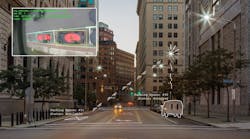As a first step, UL recently released document UL 8750 entitled "Outline of Investigation for LED Light Sources for Use in Lighting Products." This will be used as the main document within the certification organisation for all investigations of the LED light sources used in UL-listed lighting products.
All UL customers are able to download the Outline of Investigation (OOI) free of charge by visiting UL’s standards portal at www.ULstandards.com. Other users can purchase a copy of the OOI ($356 for the PDF file) at www.comm-2000.com.
During the first quarter of 2007, UL formed a balanced Standards Technical Panel (STP) to work on the drafting and publishing of an ANSI Compliant LED standard, using UL’s OOI document as a starting basis. The panel consists of all the stakeholders involved: manufacturers, testing and standards organizations, supply chain, electrical and building code inspectors, government, consumer, general interest, commercial / industrial users.
The purpose of UL's activities is that LEDs used in any type of lighting products achieve the same levels of acceptance and consumer confidence as traditional lighting technologies.
Safety issues UL says that LED manufactures must consider the following three important potential safety issues when designing their products:
Risk of shock: For this purpose, two kinds of applications are considered: LEDs supplied by a Class 2 supply and those that are either line connected or otherwise connected to a non-Class 2 supply. The first group does not present a shock hazard due to the voltage and current limitation, while the second one will need to comply with standard insulation and accessibility requirements. The only additional concern even for Class 2 supplies is for devices used in wet location, which further limits the maximum open circuit voltage to 15 VAC or 30 VDC.
Risk of fire: Many different aspects will impact the performance of a fixture (including, but not limited to: proximity between the LEDs, diffuser design and material, type of enclosure, installation, etc.). While using a Class 2 power supply reduces the risk of fire by limiting the available electrical energy, there is evidence that these systems may exceed 90 degrees C (the maximum permitted by the building code in the U.S. on combustible surfaces) due to the thermal energy dissipated by the LED in converting electrical energy to light. Therefore, it is necessary that LED luminaries are designed to take this into account and to undergo temperature testing to ensure all components within the luminary and the outside surfaces are operating within their specified temperature ratings.
Biological hazards: Issues like retinal damage and other health issues that could arise from exposure to these light sources are always a concern, but currently there is not conclusive research that proves that there is a significant risk involved with using this technology. As with any light source, using a diffuser may mitigate personal injury risks from the electromagnetic radiation it produces.

![An installer uses a cell phone to configure a connected lighting system in a Next Generation Lighting Systems (NGLS) living lab. [Photo credit: Image courtesy of Pacific Northwest National Laboratory (PNNL) and NGLS.] An installer uses a cell phone to configure a connected lighting system in a Next Generation Lighting Systems (NGLS) living lab. [Photo credit: Image courtesy of Pacific Northwest National Laboratory (PNNL) and NGLS.]](https://img.ledsmagazine.com/files/base/ebm/leds/image/2020/06/NGLS_Photo_2.5ed693de53fa2.png?auto=format,compress&fit=crop&q=45&h=139&height=139&w=250&width=250)


